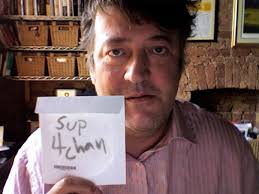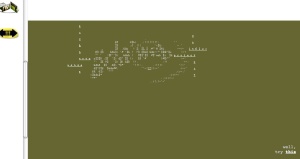In Summary: Lamentably not Stephen Fry
November 1, 2010 1 Comment

Stephen Fry: Comedian, Blogger, Polymath, self-described Whoopsie
It has actually been quite difficult for me to maintain a blog, something I rather scoffed at before this course. I was unprepared for the constancy with which you must express, elaborate and reference ideas and sources, and engagement in the online world. I don’t how Stephen Fry manages it on top of everything else the annoyingly brilliant polymath takes on.
Maintaining weekly posts has been hard for someone accustomed to wordy assignments, toyed with over several months, and while my performance on this particular assignment has been less than stellar, I’ve learn a lot and keep that with me, not least a new found appreciation for the web as a creative, intellectual and social resource.
My new found interest in Net Art continues and grows, as I am a regular visitor of netart.org. Funnily enough, Net Art was a limited subject to base my whole blog on in such a short space of time. I hope it is but the tip of the iceberg. I hope I conveyed my passion in my last post.
I really did suffer from a touch of writers block with this assignment, and the lateness of my entries shows that. I have been very impressed with some of my classmates’ blogs, and fascinated too. Sorry if I have not engaged as much as I’d like, but I was always more the observer than the performer.
On the topic of Stephen Fry, while I have lazily combed his website over the last months, I have noticed a certain voice, a certain leisurely comfortability with his blog that refreshes me. Naturally, you have to have a degree of recognition, as he does, to be so. One of his entries retreats from the opinion and examination that we often feel obliged to maintain as bloggers, and he simply talks about some personal pleasures. He calls them blogusosities, which, I think you’ll agree is a very Fry thing to say.
It starts:
‘Blogging down one’s thoughts can sometimes end in bogging them down. Political events, ideological disagreements, rants, apologies, defensive screeds and coverage of techno launches, political scandals and general media excitements have often been the meat, drink, potatoes, peanuts and popcorn of my blogging space, which is fine and well and high and dandy and adorable in its own way (one hopes) but it leaves little time for dilating on the subjects which really move and enliven me. So here is the first of a series of blogulosities in which I try and share a personal delight.’
I’m going to remember to think about some of my personal delights as well, from now on. As varied and humble as they are. Only because Stephen said I could.


